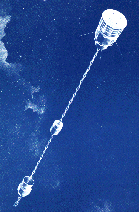 The Triad Spacraft.
| If the orbit were entirely determined by the Earth's gravity, it would be
easy to calculate and predict. At low altitudes, however, the air resistance
from the fringes of the atmosphere is not entirely negligible, and neither it
nor the effect of sunlight pressure can be accurately predicted. Triad had
floating inside it a "proof mass," a gold-platinum sphere about an inch across,
which, being completely enclosed, was affected neither by air resistance nor by sunlight. Even the feeble gravitational attraction of the
rest of the satellite was taken into account, by moving the power supply, radio
etc. (including the magnetometer) to the ends of two long booms, on opposite sides of the "proof mass".
|
 Official GSFC Home Page
Official GSFC Home Page  NASA WWW Home Page
NASA WWW Home Page